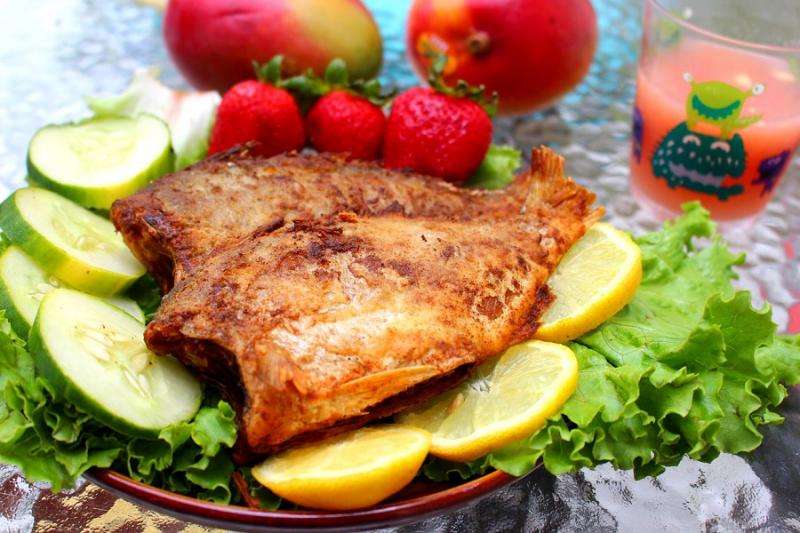Which is more wholesome—wild or farmed fish?

Choosing between wild and farmed fish is often a dilemma for consumers. Wild-captured fish cost twice as much as their farmed counterparts; a difference that many believe is justified by their better taste and nutritional properties.
However, with wild stocks declining, fish farming—also called aquaculture—provides a cheaper and more sustainable alternative to open sea fisheries.
Personal preferences rule at the fish counter. However, experts have used objective methods to judge the taste and nutritional qualities of farmed fish, and their results may put a few noses out of joint among those people who spend more to go for the wild-caught version.
"Fish coming from aquaculture can have more fat, but that's because they move less and eat more regularly than what they would do in the wild. Apart from that, the nutritional profiles can be indistinguishable," says Sadasivam Kaushik, founder-director of Fish Nutrition Laboratory at the National Institute of Agronomical Research (INRA) in Bordeaux, France.
When it comes to taste, wild fish usually have more diverse and distinct flavours, depending on the compounds they absorb from the environment, such as bromophenols, which give a distinct "sea" aroma. Many people swear to be able to distinguish wild fish once they are on the plate, but it's not always the case.
Emilio Tibaldi, a professor of aquaculture at the University of Udine who co-authored a report for the Italian Ministry of Agriculture, says that a panel of tasters he put together for the study could not distinguish between wild and farmed sea bass. "The most important factor affecting the taste and smell of fish is freshness, which has to do with their storage, rather than their origin," he explains.
The taste and texture of fish can vary a lot depending on age and environment. Each species has an optimal age and weight for consumption, and to follow the market's demand for smaller portions, some aquaculture fish are sold before they develop a full taste. At the counter, it's therefore better to spend a little more and buy fully grown individual fish.
Cultured fish have a slight advantage in safety because their lifecycle is too short to accumulate marine pollutants such as methylmercury. However, Tibaldi and Kaushik stress that both wild and farmed fish undergo rigorous controls and are safe once they reach our counters.
Waste management can be a problem for aquaculture. EU regulations oblige farmers to follow strict standards to protect the environment and the quality of products, also regarding the use of antibiotics.
If you eat fish, you are probably interested in the content of omega-3 fatty acids. These compounds are essential to the integrity of the cells' membranes and in many other physiological processes and they are considered beneficial to our health.
Some of these "good" fats come from plants. Oilseed crops, for example, are rich in alpha-linoleic acid (ALA), an omega-3 compound. Other essential omega-3, like eicosapentaenoic acid (EPA) and docosahexaenoic acid (DHA), are only found in the aquatic environment, and we can get them from algae - the primary producers - fish and other seafood.
To preserve the natural content of omega-3 oils in fish, farmers need to balance the diet of their livestock carefully through the life cycle, says Kaushik. Typically, feeds are a mixture of vegetable proteins with fishmeal and fish oil obtained from capture fisheries.
The oil, which provides the omega-3 acids, is becoming a precious, limited resource.
Worldwide, close to 18-20 million tons of fish (about 12% of the global fishery production) is captured each year and transformed into fishmeal and fish oil, contributing significantly to reducing the wild stocks. Withdouble-digit growth in demand by the aquaculture sector every year, this is hardly sustainable.
The European project ARRAINA, which Kaushik coordinates, is testing ways to lower the amount of fish-derived feeds in aquaculture. Among other things, they found that it is possible to reduce fishmeal and fish oil up to a fifth - substituting them with vegetable feeds and without affecting the health, growth, and nutritional value of that many species commonly farmed in the EU.
These results are important but may not be enough given the staggering growth in global aquaculture. Therefore, researchers worldwide are trying different ways to substitute fish oil entirely with other sources.
In 2014, the UK government approved a trial to feed salmon with camelina seeds that are genetically modified to produce EPA and DHA. Another alternative can be microalgae growed to extract the omega-3 acids. It is an interesting lead, although the costs are still prohibitive, says Tibaldi.
A further strategy is to genetically modify fish so that they can produce EPA and DHA starting from alpha-linoleic acid, which can be supplied by terrestrial plants. "Freshwater species can naturally synthesize EPA and DHA from ALA. This capability is lost in marine species, but it's still coded in their genome. The technology to induce this production is within reach. However many people still oppose GM products," says Kaushik.
Whatever the strategy, alternatives to using fish-derived oil are badly needed. The United Nation's Food and Agriculture Organisation (FAO) estimates that 70% of the fish stocks are fully or over-exploited. If we want to continue eating fish, we need a solution, and we need it fast.
Provided by Youris.com


















